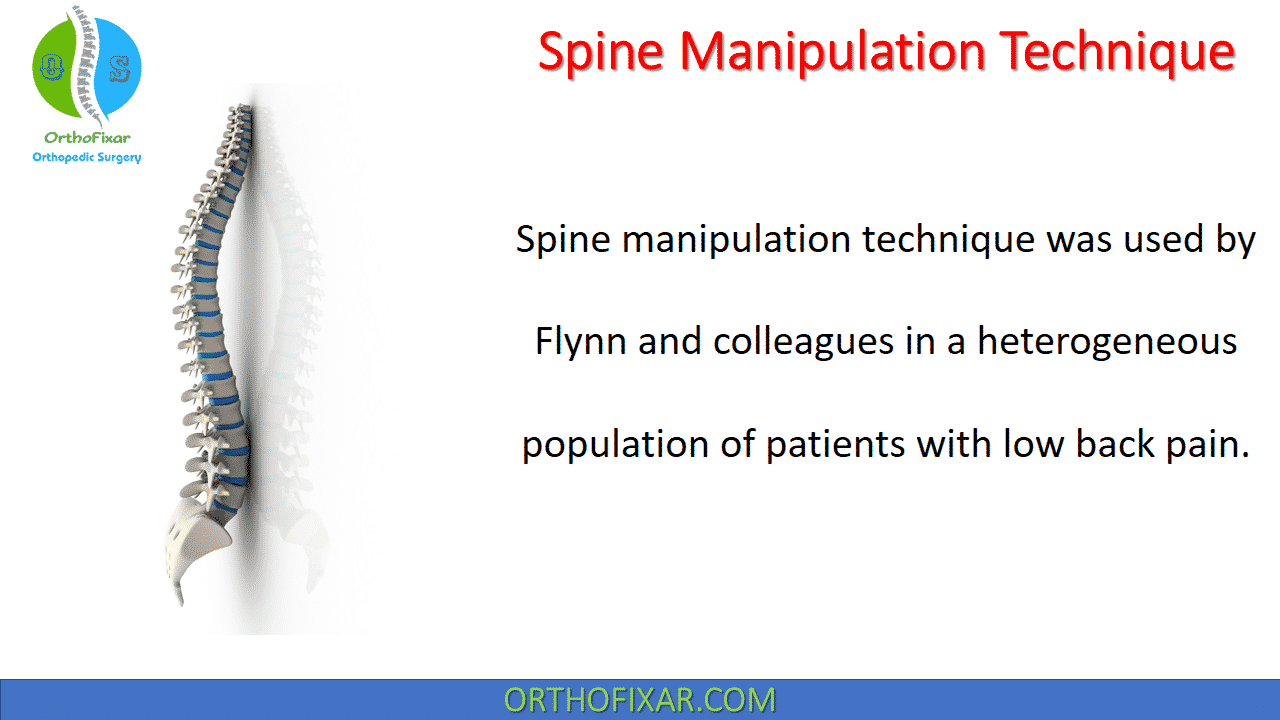Spine Manipulation Technique

Spine manipulation technique was used by Flynn and colleagues in a heterogeneous population of patients with low back pain.
See Also: Straight Leg Raise Test
Spine Manipulation Technique
The spine manipulation used was described as follows:
- The patient lies in the supine position with their hands clasped behind the neck, and the clinician stands on the side opposite to the site to be manipulated.
- The patient is passively side bent away from the clinician, by sliding the patient’s pelvis toward the clinician.
- While stabilizing the pelvis against the table with one hand, the clinician then passively rotates the patient’s trunk toward them using the other hand.
- A quick posterior and inferior thrust is then applied by the clinician to the ASIS.

Flynn and colleagues investigated the effects of the spine manipulation technique in a heterogeneous population of patients with low back pain. They identified a number of variables that were associated with a successful outcome following the manipulation. A logistics regression equation was used to identify a cluster of signs and symptoms leading to a clinical prediction rule that could significantly enhance the likelihood of identifying patients who would achieve a successful outcome with spine manipulation.
Five variables form the clinical prediction rule of the spine manipulation technique:
- symptoms for fewer than 16 days,
- no symptoms distal to the knee,
- hypomobility in the lumbar spine,
- FABQ work subscale score of less than 19,
- at least one hip with more than 35 degrees of internal rotation range of motion.
The presence of four out of five variables in the CPR increased the likelihood of success with spine manipulation from 45% to 95%.
FABQ (Fear-Avoidance Beliefs Questionnaire): Users are asked to rate their level of agreement with statements concerning beliefs about the relationship between physical activity, work, and their back pain. Level of agreement is answered on a Likert-type scale ranging from 0 (completely disagree) to 7 (completely agree). The FABQ has two parts: a seven-item work subscale (FABQW) and a four-item physical activity subscale (FABQPA). Each scale is scored separately, with higher scores representing higher levels of fear avoidance

Childs and colleagues tested the validity of the clinical prediction rule when applied in a separate patient population and by a variety of clinicians with varying levels of clinical experience and practicing in different settings. Consecutive patients with low back pain were randomized to receive either spine manipulation or a lumbar stabilization program.
The results of the study demonstrated that patients who satisfied the clinical prediction rule and received spine manipulation had significantly better outcomes than patients who did not meet the clinical prediction rule but still received spine manipulation and the group who met the clinical prediction rule but received lumbar stabilization exercises.
To make use of the clinical prediction rule more practical in a primary care environment, Fritz and colleagues tested an abbreviated version consisting of only the acuity and symptom location factors. Ninety-two percent of patients with low back pain who met both criteria had successful outcomes. The results of the Childs and colleagues and Fritz and associates studies support the findings of Flynn and colleagues and significantly increase clinician confidence in using the clinical prediction rule in decision making regarding individual patients with low back pain.
An alternative lumbar manipulation technique was described as follows:
- The patient is positioned in side lying, and the clinician stands facing the patient.
- The clinician then flexes the patient’s top leg until there is movement detected at the selected segmental interspinous space, at which point the patient’s foot is placed in the popliteal fossa of the bottom leg.
- Next, the clinician grasps the patient’s bottom shoulder and arm and introduces trunk side bending toward the table and contralateral rotation until motion is again felt at the specified interspinous space.
- Maintaining the patient’s positional setup, the patient is rolled toward the clinician. Using the arm and body, the clinician applies a high-velocity, low-amplitude thrust of the pelvis in an anterior direction.

References
- Flynn T, Fritz J, Whitman J, Wainner R, Magel J, Rendeiro D, Butler B, Garber M, Allison S. A clinical prediction rule for classifying patients with low back pain who demonstrate short-term improvement with spinal manipulation. Spine (Phila Pa 1976). 2002 Dec 15;27(24):2835-43. doi: 10.1097/00007632-200212150-00021. PMID: 12486357.
- Childs JD, Fritz JM, Flynn TW, et al. A clinical prediction rule to identify patients with low back pain most likely to benefit from spinal manipulation: a validation study. Ann Intern Med. 2004;141: 920-928.
- Fritz JM, Childs JD, Flynn TW. Pragmatic application of a clinical prediction rule in primary care to identify patients with low back pain with a good prognosis following a brief spinal manipulation intervention. BMC Fam Pract. 2005;6:29.
- Cleland JA, Fritz JM, Whitman JM, et al: The use of a lumbar spine manipulation technique by physical therapists in patients who satisfy a clinical prediction rule: A case series. J Orthop Sports Phys Ther 36:209– 214, 2006.
- Netter’s Orthopaedic Clinical Examination An Evidence-Based Approach 3rd Edition Book.
March 7, 2022
OrthoFixar
Orthofixar does not endorse any treatments, procedures, products, or physicians referenced herein. This information is provided as an educational service and is not intended to serve as medical advice.
- Lifetime product updates
- Install on one device
- Lifetime product support
- Lifetime product updates
- Install on one device
- Lifetime product support
- Lifetime product updates
- Install on one device
- Lifetime product support
- Lifetime product updates
- Install on one device
- Lifetime product support